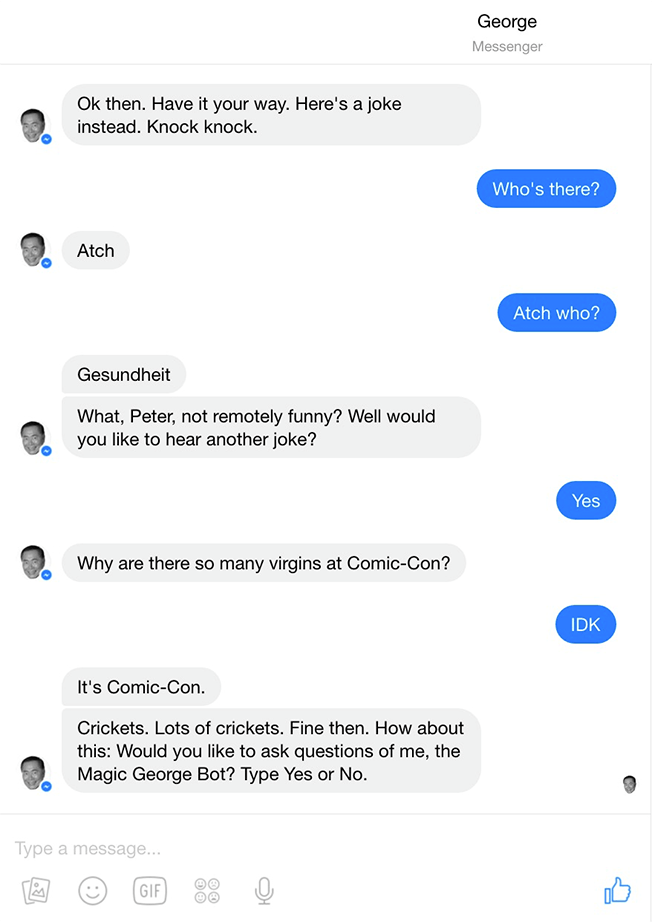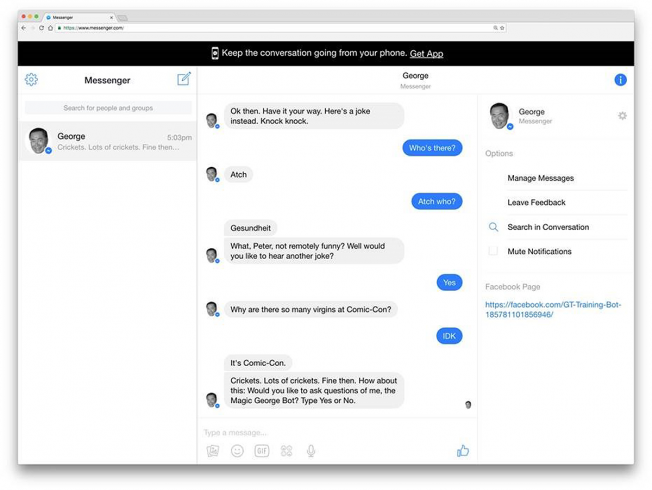In an early episode of Star Trek, Captain Kirk talks into a computer, asking for background information on another character. The scene by far outdates modern artificial intelligence assistants like Apple’s Siri, Amazon’s Alexa or Google’s Assistant. But there is something uncannily familiar—both about the way the captain talks into the machine and the way the female voice responds. Now, 50 years later, George Takei, the famed actor behind the character Hikaru Sulu, is using this same type of technology to create a chatbot.
“This is the 50th anniversary of Star Trek,” Takei told Adweek in an interview ahead of the chatbot’s launch. “And what a fortuitous time to boldly go where I hadn’t been before.” GeorgeBot—as it’s called—will operate on Facebook Messenger and feature Takei-branded content such as jokes, horoscopes, cartoons and memes that are meant to capture the personality of the actor-turned-social media star. The chatbot also includes a way for fans to leave a message for George (much like the White House chatbot that debuted this summer). The beta version will only be available to the first 1,000 people who sign up.
 The chatbot was created by The Social Edge, a social media company created by Lorenzo Thione. Thione met Takei while they were working together on the Broadway musical Allegiance, a story inspired by Takei’s family’s internment as Japanese-Americans during World War II. In fact, Thione was the one who inspired Takei to get on social media in the first place as a way to build interest in the play.
The chatbot was created by The Social Edge, a social media company created by Lorenzo Thione. Thione met Takei while they were working together on the Broadway musical Allegiance, a story inspired by Takei’s family’s internment as Japanese-Americans during World War II. In fact, Thione was the one who inspired Takei to get on social media in the first place as a way to build interest in the play.
Since then, the actor’s following has grown to more than 9.8 million followers on Facebook and another 1.8 million on Twitter. (He even wrote a book about his rise to social media stardom.) The idea first came about while Takei and Thione were talking about all the emails, social media posts and other correspondence that the star deals with on a daily basis.
Takei told Thione that he wished there was a way to better keep up with talking to all of his fans. At that point, Thione–who has a history of working with artificial and natural language while working on the search engine that later became Bing—had an idea. “I just actually made a joke talking about Star Trek,” Thione said. “I said wouldn’t it be amazing if you could just download yourself to a computer and just be the one who responds to everything?”
This isn’t Thione’s first involvement with AI. In a previous role, he was a research scientist at Xerox Parc, where he embedded tech into the search engine that was originally used to create Bing before it was acquired by Microsoft. In some ways, he said he hopes the chatbot will allow him to go back to his roots, while tackling more complex issues related to AI and natural language processing (which would allow the bot to actually seem like Takei.)
At some point, he said, he wants GeorgeBot to have Takei’s own voice—just like the voice of the onboard computer in the show. All jokes and memes and horoscopes aside, the bot could someday also have more of a serious side.
Takei, who has been a champion for LGBT rights, said the platform could be a way to connect with people on a platform other than Twitter and Facebook. That could be useful both for having a direct way for interacting with fans, but also for dealing with trolls. GeorgeBot is also able to notice hateful expressions and respond accordingly, which allows Takei to respond to them without actually having to directly deal with them. “I have more problems with me live,” he said. “I sometimes say things that go viral and it takes a whole weekend before we can tap that down.”

Takei said he’s impressed to see how much of Star Trek’s science fiction from the 1960s is now real today. “We live in a science fiction world,” he said. “And now we have our surrogate roaming around Mars collecting information, and it won’t be too long before humans will be [there too].” Star Trek’s track record of being ahead of the curve is well documented. It invented the flip phone long before anyone had a flip phone. It featured a universal translator, which would allow characters to talk to each other in any language. (A startup recently completed a campaign to do the same thing for several languages, and Google has made plenty of progress with Google Translate.)
Takei said humans are “always intrigued about the unimagined.” “People who imagine the unimagined create a goal for scientists and technicians,” he said. “It takes people like Lorenzo to say ‘Oh wow, we can do that.’ And they start experimenting, and then by trial and error, step by step, chatbots to robots to holograms. And we reach that point where we make our fiction today very real. And then they start speculating about what else the human animal can imagine and that imagination is what keeps us moving forward.”
So what’s next? Takei, who already has his own hologram, said there’s another Star Trek technology that Takei said he’d love to try someday to keep up with his busy schedule. “What I earnestly pray for is the early development of the transporter,” he said.